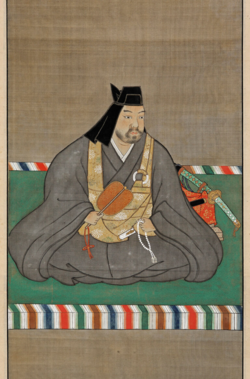Uesugi Kenshin | |
|---|---|
上杉 謙信 | |
 Portrait from Uesugi Shrine | |
| Head of Uesugi clan | |
| In office 1561–1578 | |
| Preceded by | Uesugi Norimasa |
| Succeeded by | Uesugi Kagekatsu |
| Head of Nagao clan | |
| In office 1548–1578 | |
| Preceded by | Nagao Harukage |
| Succeeded by | Uesugi Kagekatsu |
| Personal details | |
| Born | Nagao Kagetora February 18, 1530 Echigo Province, Japan |
| Died | April 19, 1578 (aged 48) Echigo Province, Japan |
| Parents |
|
| Relatives |
|
| Nicknames |
|
| Military service | |
| Allegiance | Nagao clan Uesugi clan |
| Rank | Lord (Daimyō), Kanrei |
| Commands | Kasugayama Castle |
| Battles/wars | Siege of Tochio (1544) Battle of Fuse (1553) Battle of Saigawa (1555) Battle of Uenohara (1557) Siege of Odawara (1561) Battle of Kawanakajima (1561) Siege of Karasawa (1563) Battle of Shiozaki (1564) Siege of Matsukura (1568) Battle of Tonegawa (1571) Siege of Kanayama (1574) Siege of Nanao (1576, 1577) Battle of Tedorigawa (1577) |
Nagao Kagetora (長尾 景虎, February 18, 1530 – April 19, 1578[1]), later known as Uesugi Kenshin (上杉 謙信), was a Japanese daimyō. He was born in Nagao clan,[2] and after adoption into the Uesugi clan, ruled Echigo Province in the Sengoku period of Japan.[3] He was one of the most powerful daimyō of the Sengoku period. Known as the "Dragon of Echigo", while chiefly remembered for his feats and prowess on the battlefield as a military genius and war hero, Kenshin is also regarded as an extremely skillful administrator who fostered the growth of local industries and trade, and his rule saw a marked rise in the standard of living of Echigo.
Kenshin is famed for his honourable conduct, his military expertise, a long-standing rivalry with Takeda Shingen, his numerous defensive campaigns to restore order in the Kantō region as the Kanto Kanrei, and his belief in the Buddhist god of war Bishamonten. Many of his followers and others believed him to be the avatar of Bishamonten, and called Kenshin the "God of War".
- ^ Uesugi Kenshin at the Encyclopædia Britannica
- ^ Dupuy, Johnson & Bongard 1992, p. 765.
- ^ Turnbull 1987, pp. 41, 44.